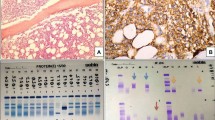Abstract
Background
Plasma cell dyscrasias (PCD) comprise a wide spectrum of disorders, which may adversely affect the kidney. However, in some PCD cases associated with kidney disease, the routine laboratory tests may be incapable to determine precisely the form of PCD, i.e., benign or malignant. Moreover, the kidney biopsy needed for precise diagnosis may be risky or declined. To overcome these limitations, we have developed and reported a new non-invasive technique based on serum free light chains (FLC) monomer (M) and dimer (D) pattern analysis (FLC MDPA), which allowed differentiation between malignant and benign PCD forms. The objective of our retrospective study was to demonstrate the utility of FLC MDPA in solving ten puzzling PCD cases complicated with kidney disease (patients 1–10).
Methods
Ten patients with uncertain form of PCD or with a questionable response to treatment were studied. In addition to routine laboratory tests and clinical evaluation of the PCD patients, our previously developed FLC MDPA in sera and biochemical amyloid typing in biopsy tissues were applied.
Results
The FLC MDPA aided the diagnosis of the PCD underlying or accompanying the kidney disease in patients 1–5, and helped to interpret properly the response to treatment in patients 1, 6–10. The FLC MDPA findings were confirmed by a biochemical analysis of tissue amyloid deposits and subsequently by the outcome of these patients.
Conclusions
FLC MDPA is a non-invasive diagnostic test useful in the management of ambiguous cases of PCD associated with kidney disease.







Similar content being viewed by others
References
Gallo GR, Feiner HD, Chuba JV, Beneck D, Marion P, Cohen DH. Characterization of tissue amyloid by immunofluorescencemicroscopy. Clin Immunol Immunopathol. 1986;39:479–90.
Kaplan B, Hrncic R, Murphy CL, Gallo G, Weiss DT, Solomon A. Microextraction and purification techniques applicable to the characterization of amyloid proteins in minute amounts of tissue. Methods Enzymol. 1999;309:67–81.
Kaplan B, Martin BM, Livneh A, Pras M, Gallo G. Biochemical micro-techniques in the diagnosis and classification of amyloidosis. Curr Pharm Anal. 2006;2:45–52.
Murphy CL, Wang S, Williams T, Weiss DT, Solomon A. Characterization of systemic amyloid deposits by mass spectrometry. Methods Enzymol. 2006;412:48–62.
Brambilla F, Lavatelli F, Merlini G, Mauri P. Clinical proteomics for diagnosis and typing of systemic amyloidoses. Proteom Clin Appl. 2013;7:136–43.
Palladini G, Russo P, Bosoni T, et al. Identification of amyloidogenic light chains requires the combination of serum-free light chain assay with immunofixation of serum and urine. Clin Chem. 2009;55:499–504.
Lachmann HJ, Gallimore R, Gillmore JD, et al. Outcome in systemic AL amyloidosis in relation to changes in concentration of circulating free immunoglobulin light chains following chemotherapy. Br J Haematol. 2003;122:78–84.
Kaplan B, Ramirez-Alvarado M, Sikkink L, et al. Free light chains in plasma of patients with light chain amyloidosis and non-amyloid light chain deposition disease. High proportion and heterogeneity of disulfide-linked monoclonal free light chains as pathogenic features of amyloid disease. Br J Haematol. 2009;144:705–15.
Kaplan B, Golderman S, Aizenbud B, et al. Immunoglobulin-free light chain monomer-dimer patterns help to distinguish malignant from premalignant monoclonal gammopathies: a pilot study. Am J Hematol. 2014;89:882–8.
Gatt ME, Kaplan B, Yogev D, et al. The use of serum free light chain dimerization patterns assist in the diagnosis of AL amyloidosis. Br J Haematol. 2018;182:86–92.
Comenzo RL, Reece D, Palladini G, et al. Consensus guidelines for the conduct and reporting of clinical trials in systemic light-chain amyloidosis. Leukemia. 2012;26:2317–35.
Kaplan B, Aizenbud BM, Golderman S, Yaskariev R, Sela. BA. Free light chain monomers in the diagnosis of multiple sclerosis. J Neuroimmunol. 2010;229:263–73.
Kaplan B, Martin BM, Livneh A, Pras M, Gallo GR. Biochemical subtyping of amyloid in formalin-fixed tissue confirms and supplements immunohistological data. Am J Clin Pathol. 2004;121:794–800.
Bradwell AR. Serum free light chain analysis (plus Hevylite). 6th ed. Birmingham: The Binding Site Group Ltd; 2010.
Connors LH, Jiang Y, Budnik M, et al. Heterogeneity in primary structure, post-translational modifications, and germline gene usage of nine full-length amyloidogenic k1 immunoglobulin light chains. Biochemistry. 2007;46:14259–71.
Wilkinson W, Gilbert H. Protein disulfide isomerase. Biochim Biophys Acta. 2004;1699:35–44.
Migrino RQ, Hari P, Gutterman DD, et al. Systemic and microvascular oxidative stress induced by light chain amyloidosis. Int J Cardiol. 2010;145:67–8.
Sharma A, Tripathi M, Satyam A, Kumar L. Study on antioxidant level in patients with multiple myeloma. Leuk Lymphoma. 2009;50:809–15.
Acknowledgements
We would like to thank Dr. R. Kaplan for his invaluable advice and helpful discussion in the preparation of this manuscript.
Author information
Authors and Affiliations
Corresponding author
Ethics declarations
Conflict of interest
The authors have declared that no conflict of interest exists.
Ethical approval
All procedures performed in studies involving human participants were in accordance with the ethical standards of the institutional and/or national research committee at which the studies were conducted (IRB approval number 2982-16-SMC) and with the 1964 Helsinki Declaration and its later amendments or comparable ethical standards.
Informed consent
For this type of study (retrospective), formal informed consent was not required.
Additional information
Publisher’s Note
Springer Nature remains neutral with regard to jurisdictional claims in published maps and institutional affiliations.
About this article
Cite this article
Kukuy, O., Kaplan, B., Golderman, S. et al. Kidney disease and plasma cell dyscrasias: ambiguous cases solved by serum free light chain dimerization analysis. Clin Exp Nephrol 23, 763–772 (2019). https://doi.org/10.1007/s10157-019-01699-5
Received:
Accepted:
Published:
Issue Date:
DOI: https://doi.org/10.1007/s10157-019-01699-5




